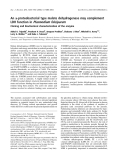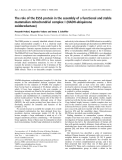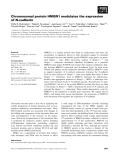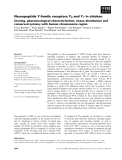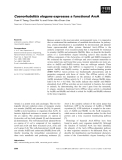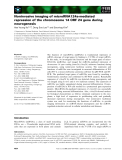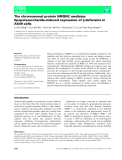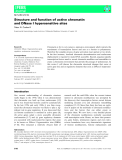
Chromosome function
-
The centromere–kinetochore complex is a highly specialized chromatin domain that both mediates and monitors chromosome–spindle interactions responsible for accurate partitioning of sister chromatids to daughter cells. Centromeres are distinguished from adjacent chromatin by specific patterns of histone modification and the presence of a centromere-specific histone H3 variant (e.g. CENP-A). Centromere-proximal regions usually correspond to sites of avid and persistent sister chromatid cohesion mediated by the conserved cohesin complex.
 15p
15p  research12
research12
 01-06-2013
01-06-2013
 49
49
 4
4
 Download
Download
-
Mammalian alcohol dehydrogenases (ADH) 3 form a com-plex enzyme system based on amino-acid sequence, func-tional properties, and gene expression pattern. At least four mouseAdhgenes are known to encode dierent enzyme classes that share less than 60% amino-acid sequence iden-tity. Two ADH-containing and overlapping C57BL/6 bacterial arti®cial chromosome clones, RP23-393J8 and -463H24, were identi®ed in a library screen, physically mapped, and sequenced.
 9p
9p  research12
research12
 29-04-2013
29-04-2013
 23
23
 2
2
 Download
Download
-
BLASTanalysis of the human and mouse genome sequence databases using the sequence of the human CMP-sialic acid:b-galactoside a-2,6-sialyltransferase cDNA (hST6Gal I, EC2.4.99.1) as a probe allowed us to identify a putative sialyltransferase gene on chromosome 2. The sequence of the corresponding cDNA was also found as an expressed sequence tag of human brain.
 12p
12p  tumor12
tumor12
 20-04-2013
20-04-2013
 28
28
 2
2
 Download
Download
-
There are at least two membrane-bound (HynSL and HupSL) and one soluble (HoxEFUYH) [NiFe]hydrogen-ases in Thiocapsa roseopersicinaBBS, a purple sulfur photosynthetic bacterium. Genes coding for accessory pro-teins that participate in the biosynthesis and maturation of hydrogenases seem to be scattered along the chromosome. Transposon-based mutagenesis was used to locate the hydrogenase accessory genes.
 10p
10p  fptmusic
fptmusic
 16-04-2013
16-04-2013
 34
34
 3
3
 Download
Download
-
Analysis of a draft nuclear genome sequence of the diatomThalassiosira pseudonana revealed the presence of 11 open reading frames showing significant similarity to functionally characterized fatty acid front-end desaturases. The corresponding genes occupy discrete chromosomal loca-tions as determined by comparison with the recently published genome sequence. Phylogenetic analysis showed that two of the T. pseudonana desaturase (Tpdes) sequences grouped with proteobacterial desaturases that lack a fused cytochrome b5 domain. ...
 12p
12p  fptmusic
fptmusic
 11-04-2013
11-04-2013
 32
32
 2
2
 Download
Download
-
Malate dehydrogenase (MDH) may be important in car-bohydrate and energymetabolism inmalarial parasites. The cDNA corresponding to the MDHgene, identified on chromosome 6 of thePlasmodium falciparumgenome, was amplified by RT-PCR, cloned and overexpressed in Escherichia coli. The recombinant PfMDH was purified to homogeneity and biochemically characterized as an NAD + (H)-specific MDH, which catalysed reversible inter-conversion of malate to oxaloacetate.
 15p
15p  awards
awards
 05-04-2013
05-04-2013
 77
77
 7
7
 Download
Download
-
The ESSS protein is a recently identified subunit of mam-malian mitochondrial complex I. It is a relatively small integral membrane protein (122 amino acids) found in the b-subcomplex. Genomic sequence database searches reveal its localization to theX-chromosome inhumans andmouse. TheESSScDNAfromChinesehamster cellswas clonedand shown to complement one complementation group of our previously described mutants with a proposed X-linkage. Sequence analyses of the ESSS cDNA in these mutants revealed chain termination mutations. ...
 9p
9p  awards
awards
 05-04-2013
05-04-2013
 35
35
 5
5
 Download
Download
-
HMGN1 is a nuclear protein that binds to nucleosomes and alters the accessibility of regulatory factors to their chromatin targets. To elucidate its biological function and identify specific HMGN1 target genes, we gener-ated Hmgn1–⁄– mice. DNA microarray analysis of Hmgn1+⁄+ and Hmgn1–⁄– embryonic fibroblasts identified N-cadherin as a potential HMGN1 gene target.
 11p
11p  dell39
dell39
 27-03-2013
27-03-2013
 37
37
 3
3
 Download
Download
-
The peptides of the neuropeptide Y (NPY) family exert their functions, including regulation of appetite and circadian rhythm, by binding to G-protein coupled receptors. Mammals have five subtypes, named Y1,Y2 , Y4,Y5 and Y6, and recently Y7 has been discovered in fish and amphibi-ans. In chicken we have previously characterized the first four subtypes and here we describe Y6 and Y7.
 16p
16p  inspiron33
inspiron33
 26-03-2013
26-03-2013
 35
35
 4
4
 Download
Download
-
Because arsenic is the most prevalent environmental toxin, it is imperative that we understand the mechanisms of metalloid detoxification. In prokary-otes, arsenic detoxification is accomplished by chromosomal and plasmid-borne operon-encoded efflux systems.
 7p
7p  galaxyss3
galaxyss3
 21-03-2013
21-03-2013
 41
41
 2
2
 Download
Download
-
Chromosomal rearrangements apparently account for the presence of a pri-mate-specific gene (protease serine 3) in chromosome 9. This gene encodes, as the result of alternative splicing, both mesotrypsinogen and trypsino-gen 4. Whereas mesotrypsinogen is known to be a pancreatic protease, neither the chemical nature nor biological function of trypsinogen 4 has been explored previously.
 11p
11p  galaxyss3
galaxyss3
 21-03-2013
21-03-2013
 41
41
 3
3
 Download
Download
-
The function of microRNAs (miRNAs) is translational repression or mRNA cleavage of target genes by binding to 3¢-UTRs of target mRNA. In this study, we investigated the functions and the target genes of micro-RNA124a (miR124a), and imaged the miR124a-mediated repression of chromosome 14 open reading frame24(c14orf24, unknown function) during neurogenesis, using noninvasive luciferase systems.
 12p
12p  vinaphone15
vinaphone15
 25-02-2013
25-02-2013
 30
30
 2
2
 Download
Download
-
Humanb-defensin-2 (HBD-2) is an antimicrobial peptide produced by the epithelial cells that plays an important role in innate and adaptive immu-nity. Here we report that high mobility group protein N2 (HMGN2), a member of the high mobility group superfamily that affects chromatin function, modulates the expression of HBD-2 in A549 cells treated by lipo-polysaccharide.
 15p
15p  cosis54
cosis54
 05-01-2013
05-01-2013
 49
49
 4
4
 Download
Download
-
Chromatin is by its very nature a repressive environment which restricts the recruitment of transcription factors and acts as a barrier to polymerases. Therefore the complex process of gene activation must operate at two levels. In the first instance, localized chromatin decondensation and nucleosome displacement is required to make DNA accessible.
 29p
29p  cosis54
cosis54
 05-01-2013
05-01-2013
 48
48
 5
5
 Download
Download
CHỦ ĐỀ BẠN MUỐN TÌM









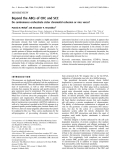
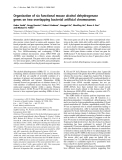
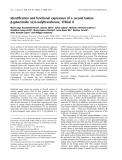
![Báo cáo khoa học: Accessory proteins functioning selectively and pleiotropically in the biosynthesis of [NiFe] hydrogenases in Thiocapsa roseopersicina Báo cáo khoa học: Accessory proteins functioning selectively and pleiotropically in the biosynthesis of [NiFe] hydrogenases in Thiocapsa roseopersicina](https://tailieu.vn/image/document/thumbnail/2013/20130416/fptmusic/135x160/741366103372.jpg)

